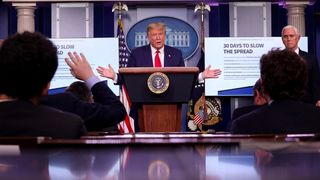Death is on the President’s mind. On Tuesday in the White House briefing room, Donald Trump said: “Our country is in the midst of a great national trial unlike anything we have faced ever before … We’re going to go through a very tough two weeks.”
Two days earlier, Trump discussed the modelling presented to him by his two leading pandemic advisors, Dr Anthony Fauci and Dr Deborah Birx: “So you’re talking about 2.2 million deaths, 2.2 million people from this. And so if we could hold that down, as we’re saying, to 100,000 — it’s a horrible number, maybe even less — but to 100,000. So we have between 100 [thousand] and 200,000, and we altogether have done a very good job."
“So you’re talking about 2.2 million deaths, 2.2 million people from this. And so if we could hold that down, as we’re saying, to 100,000 — it’s a horrible number, maybe even less — but to 100,000. So we have between 100 [thousand] and 200,000, and we altogether have done a very good job."US President Donald Trump
That modelling has now been presented to the American people. Even with current mitigation plans and programs, expected deaths in the coming weeks are between 100,000 and 240,000 people. In discussing the crisis in these terms, Trump has arrived at an entirely new place.
On January 22, when asked if we should be worried about the virus in China, Trump said: “No. Not at all. And we have it totally under control. It’s one person coming in from China, and we have it under control. It’s going to be just fine.”
On January 30: “We have it very well under control. We have very little problem in this country at this moment – five. And those people are all recuperating successfully.”
February 10: “Looks like by April, you know, in theory, when it gets a little warmer, it miraculously goes away.”
February 27: “It’s going to disappear. One day – it’s like a miracle – it will disappear.”
March 10: “It will go away. Just stay calm. It will go away.”
While it is always treacherous to play politics during a national catastrophe – today, a pandemic and a recession – there are two fronts of vulnerability for Trump.
On the pandemic, a case is evident that testing for the virus was bungled, with at least one month of testing lost, propelling Americans into an enormous rate of infection, and that critical actions to procure essential equipment and supplies for hospitals were delayed, compromising urgent treatment. Together, these lapses put the US on the wrong side of the infection curve.
While Joe Biden, the all-but-certain Democratic nominee for president, is leading in several polls, it is hardly a commanding position. He has issued several potent attack ads to undercut Trump, and they have been viewed by millions.
Everyone knows that we're facing a real crisis from the coronavirus. But do you know how we got here and what we need to do next? Ron Klain, former White House Ebola Response Coordinator, breaks it down for us: pic.twitter.com/XRkIw2EzM4
— Joe Biden (@JoeBiden) March 21, 2020
And as New York Governor Andrew Cuomo said this week: "I am tired of being behind this virus. We've been behind this virus from day one. The virus was in China; we knew it was in China ... You don't win playing catch-up. You have to get ahead of it."
On the shutdown of the economy, the livelihoods of tens of millions of American households are being destroyed, with no sufficient safety net, notwithstanding the $2.2 trillion relief package and the actions of the Federal Reserve. Unemployment may well rise to 20 per cent.
Trump’s approval today for managing the crisis is 60 per cent. His daily television briefings are reaching a huge audience and have superseded his campaign rallies in communicating with the public. And Trump gives himself high marks, as he said earlier this week on Fox News: “I’ve gotten great marks on what we’ve done with respect to this. I’ve gotten great marks. And even from almost every Democrat governor, so I’ve gotten great marks also. But we want to always make sure that we have a great president, that we have somebody that’s capable.”
In raw political terms, that is exactly the issue: Can an incumbent president survive a recession and 100,000 or more deaths from the virus?
This would be the highest loss of American lives since World War II (over 405,000) and a toll that exceeds deaths from recent wars, violence and addiction. The US lost 58,220 men and women in Vietnam, and 54,260 in Korea.
Can an incumbent president survive a recession and 100,000 or more deaths from the virus? This would be the highest loss of American lives since World War II
Guns kill over 36,000 Americans each year. Opioids killed 67,300 Americans last year.
President Trump said: “The country’s come together like I’ve never seen it before.”
Will that hold in November?
Trump now presents himself to the American people as a “wartime president”, fighting an “invisible enemy”. He promises complete victory. This is indeed the greatest crisis of his term in office, and a defining moment. But even triumph over tyranny has not ensured renewed political triumph. Winston Churchill was ousted from power by the British people after winning World War II. George H. W. Bush was defeated by Bill Clinton just 18 months after liberating Kuwait from Saddam’s Iraq.
Will 100,000 or 200,000 Americans dead from coronavirus be seen as “a good job”? Or is there a morbidity benchmark that hurts President Trump in his quest for re-election?






